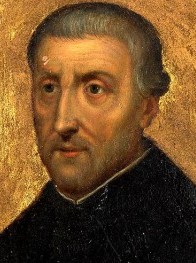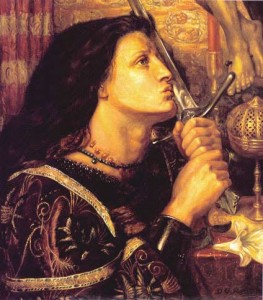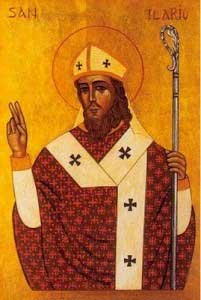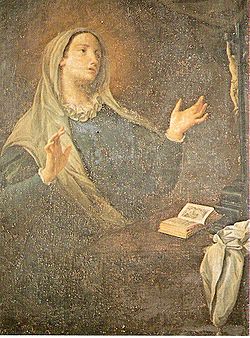Saints
St. Peter Canisius…”faithful to dogma, respectful to people”
VATICAN CITY, 9 FEB 2011 (VIS) – Benedict XVI dedicated his catechesis during this morning’s general audience to St. Peter Canisius, whom Leo XIII proclaimed as “the second apostle of Germany”, and who was subsequently canonised and proclaimed as a Doctor of the Church by Pius XI in 1925.
Born at Nijmegen in the Netherlands in 1521, Peter Canisius entered the Society of Jesus in 1543 and was ordained a priest in 1546. In 1548, St. Ignatius of Loyola sent him to complete his spiritual formation in Rome. A year later he moved to the Duchy of Bavaria where he became dean and rector of the University of Ingolstadt. Later he was administrator of the diocese of Vienna, Austria, where he practiced his pastoral ministry in hospitals and prisons. In the year 1566 he founded the College of Prague and, until 1569, was the first superior of the Jesuit province of upper Germany.
In this role he created a network of Jesuit communities in Germanic countries, especially schools, which became starting points for the Catholic Reformation. He participated in religious discussions with Protestant leaders, including Melanchthon, held in the city of Worms, acted as pontifical nuncio to Poland, participated in the two Diets of Augsburg in 1559 and in 1565, and attended the closing session of the Council of Trent. In 1580 he retired to Fribourg in Switzerland where he dedicated himself to writing and where he died in 1597. Peter Canisius also edited the complete works of Cyril of Alexandria and of St. Leo the Great, and the Letters of St. Jerome.
Among his most famous works were his three “Catechises”, written between 1555 and 1558. The first was aimed at students capable of understanding the basic notions of theology; the second at ordinary young people for their primary religious education; and the third at children with a medium- or secondary-school education.
“One characteristic of St. Peter Canisius”, said the Holy Father, was “that he was able to harmonise fidelity to dogmatic principles with the respect due to each individual. … In a historical period of deep confessional contrasts, he avoided severity and the rhetoric of anger, something fairly rare in discussions among Christians at that time, … and sought only to explain our spiritual roots and to revitalise faith in the Church”.
“In the works destined for the spiritual education of the masses, our saint insists on the importance of the liturgy, … the rites of Mass and the other Sacraments. However, at the same time, he is careful to show the faithful the importance and beauty of individual daily prayer to accompany and permeate participation in the Church’s public worship”, said Benedict XVI, pointing our that “this exhortation and this methodology maintain all their value, especially after being authoritatively re-presented by Vatican Council II”.
Peter Canisius “clearly teaches that apostolic ministry is incisive and produces fruits of salvation in people’s hearts only if the preacher is a personal witness of Jesus and knows how to become His instrument, closely bound to Him through faith in His Gospel and in His Church, through a morally coherent life and incessant prayer”. AG/VIS 20110209 (530)
The Second Meditation – Introduction to the Devout Life: Chapter 10 by St. Francis de Sales audio mp3 edition – Discerning Hearts
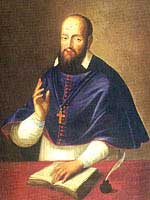 Introduction to the Devout Life
Introduction to the Devout Life
By
St. Francis de Sales
read by Omar F. A. Guiterrez
Chapter 10 – The Second Meditation :
Podcast: Play in new window | Download (5.9MB) | Embed
Subscribe: Apple Podcasts | Spotify | Amazon Music | Android | Pandora | iHeartRadio | JioSaavn | Podchaser | Gaana | Podcast Index | Email | TuneIn | Deezer | Anghami | RSS | More
For the pdf containing the complete text and footnotes click here
Other audio meditations from the Introduction of the Devout Life
Of the End for which we were Created.
Preparation.
1. PLACE yourself before God.
2. Ask Him to inspire your heart.Considerations.
1. God did not bring you into the world because He had any need of you, useless as you are; but solely that He might show forth His Goodness in you, giving you His Grace and Glory. And to this end He gave you understanding that you might know Him, memory that you might think of Him, a will that you might love Him, imagination that you might realise His mercies, sight that you might behold the marvels of His works, speech that you might praise Him, and so on with all your other faculties.
2. Being created and placed in the world for this intent, all contrary actions should be shunned and rejected, as also you should avoid as idle and superfluous whatever does not promote it.
3. Consider how unhappy they are who do not think of all this,—who live as though they were created only to build and plant, to heap up riches and amuse themselves with trifles.Affections and Resolutions.
1. Humble yourself in that hitherto you have so little thought upon all this. Alas, my God, of what was I thinking when I did not think of Thee? what did I remember when I forgot Thee? what did I love when I loved Thee not? Alas, when I ought to have been feeding on the truth, I was but filling myself with vanity, and serving the world, which was made to serve me.
2. Abhor your past life. I renounce ye, O vain thoughts and useless cogitations, frivolous and hateful memories: I renounce all worthless friendships, all unprofitable efforts, and miserably ungrateful self-indulgence, all pitiful compliances.
3. Turn to God. Thou, my God and Saviour shalt henceforth be the sole object of my thoughts; no more will I give my mind to ideas which are displeasing to Thee. All the days of my life I will dwell upon the greatness of Thy Goodness, so lovingly poured out upon me. Thou shalt be henceforth the delight of my heart, the resting-place of all my affections. From this time forth I will forsake and abhor the vain pleasures and amusements, the empty pursuits which have absorbed my time;—the unprofitable ties which have bound my heart I will loosen henceforth, and to that end I will use such and such remedies.Conclusion.
1. Thank God, Who has made you for so gracious an end. Thou hast made me, O Lord, for Thyself, that I may eternally enjoy the immensity of Thy Glory; when shall I be worthy thereof, when shall I know how to bless Thee as I ought?
2. Offer. O Dearest Lord, I offer Thee all my affections and resolutions, with my whole heart and soul.
3. Pray. I entreat Thee, O God, that Thou wouldest accept my desires and longings, and give Thy Blessing to my soul, to enable me to fulfil them, through the Merits of Thy Dear Son’s Precious Blood shed upon the Cross for me.OUR FATHER, etc. Gather your little spiritual bouquet.
The Third Meditation – Introduction to the Devout Life: Chapter 11 by St. Francis de Sales audio mp3 edition – Discerning Hearts
 Introduction to the Devout Life
Introduction to the Devout Life
By
St. Francis de Sales
read by Omar F. A. Guiterrez
Chapter 11 – The Third Meditation :
Podcast: Play in new window | Download (Duration: 6:27 — 5.9MB) | Embed
Subscribe: Apple Podcasts | Spotify | Amazon Music | Android | Pandora | iHeartRadio | JioSaavn | Podchaser | Gaana | Podcast Index | Email | TuneIn | Deezer | Anghami | RSS | More
For the pdf containing the complete text and footnotes click here
Other audio meditations from the Introduction of the Devout Life
Of the Gifts of God
Preparation.
1. PLACE yourself in the Presence of God.
2. Ask Him to inspire your heart.Considerations.
1. Consider the material gifts God has given you—your body, and the means for its preservation; your health, and all that maintains it; your friends and many helps. Consider too how many persons more deserving than you are without these gifts; some suffering in health or limb, others exposed to injury, contempt and trouble, or sunk in poverty, while God has willed you to be better off.
2. Consider the mental gifts He has given you. Why are you not stupid, idiotic, insane like many you wot of? Again, God has favoured you with a decent and suitable education, while many have grown up in utter ignorance.
3. Further, consider His spiritual gifts. You are a child of His Church, God has taught you to know Himself from your youth. How often has He given you His Sacraments? what inspirations and interior light, what reproofs, He has given to lead you aright; how often He has forgiven you, how often delivered you from occasions of falling; what opportunities He has granted for your soul’s progress! Dwell somewhat on the detail, see how Loving and Gracious God has been to you.Affections and Resolutions.
1. Marvel at God’s Goodness. How good He has been to me, how abundant in mercy and plenteous in loving-kindness! O my soul, be thou ever telling of the great things the Lord has done for thee!
2. Marvel at your own ingratitude. What am I, Lord, that Thou rememberest me? How unworthy am I! I have trodden Thy Mercies under root, I have abused Thy Grace, turning it against Thy very Self; I have set the depth of my ingratitude against the deep of Thy Grace and Favour.
3. Kindle your gratitude. O my soul, be no more so faithless and disloyal to thy mighty Benefactor! How should not my whole soul serve the Lord, Who has done such great things in me and for me?
4. Go on, my daughter, to refrain from this or that material indulgence; let your body be wholly the servant of God, Who has done so much for it: set your soul to seek Him by this or that devout practice suitable thereto. Make diligent use of the means provided by the Church to help you to love God and save your soul. Resolve to be constant in prayer and seeking the Sacraments, in hearing God’s Word, and in obeying His inspirations and counsels.Conclusion.
1. Thank God for the clearer knowledge He has given you of His benefits and your own duty.
2. Offer your heart and all its resolutions to Him.
3. Ask Him to strengthen you to fulfil them faithfully by the Merits of the Death of His Son.OUR FATHER, etc.
Gather the little spiritual bouquet.
The Fifth Meditation – Introduction to the Devout Life: Chapter 13 by St. Francis de Sales audio mp3 edition – Discerning Hearts
 Introduction to the Devout Life
Introduction to the Devout Life
By
St. Francis de Sales
read by Omar F. A. Guiterrez
Chapter 13 – The Fifth Mediation :
Download (right click & choose “Save Link As”)For the pdf containing the complete text and footnotes click here
Other audio meditations from the Introduction of the Devout Life
Of Death.Preparation.
1. PLACE yourself in the Presence of God.
2. Ask His Grace.
3. Suppose yourself to be on you death bed, in the last extremity, without the smallest hope of recovery.Considerations.
1. Consider the uncertainty as to the day of your death. One day your soul will quit this body—will it be in summer or winter? in town or country? by day or by night? will it be suddenly or with warning? will it be owing to sickness or an accident? will you have time to make your last confession or not? will your confessor or spiritual father be at hand or will he not? Alas, of all these things we know absolutely nothing: all that we do know is that die we shall, and for the most part sooner than we expect.
2. Consider that then the world is at end as far as you are concerned, there will be no more of it for you, it will be altogether overthrown for you, since all pleasures, vanities, worldly joys, empty delights will be as a mere fantastic vision to you. Woe is me, for what mere trifles and unrealities I have ventured to offend my God? Then you will see that what we preferred to Him was nought. But, on the other hand, all devotion and good works will then seem so precious and so sweet:—Why did I not tread that pleasant path? Then what you thought to be little sins will look like huge mountains, and your devotion will seem but a very little thing.
3. Consider the universal farewell which your soul will take of this world. It will say farewell to riches, pleasures, and idle companions; to amusements and pastimes, to friends and neighbours, to husband, wife and child, in short to all creation. And lastly it will say farewell to its own body, which it will leave pale and cold, to become repulsive in decay.
4. Consider how the survivors will hasten to put that body away, and hide it beneath the earth—and then the world will scarce give you another thought, or remember you, any more than you have done to those already gone. “God rest his soul!” men will say, and that is all. O death, how pitiless, how hard thou art!
5. Consider that when it quits the body the soul must go at once to the right hand or the left. To which will your soul go? what side will it take? none other, be sure, than that to which it had voluntarily drawn while yet in this world.Affections and Resolutions.
1. Pray to God, and throw yourself into His Arms. O Lord, be Thou my stay in that day of anguish! May that hour be blessed and favourable to me, if all the rest of my life be full of sadness and trial.
2. Despise the world. Forasmuch as I know not the hour in which I must quit the world, I will not grow fond of it. O dear friends, beloved ones of my heart, be content that I cleave to you only with a holy friendship which may last for ever; why should I cling to you with a tie which must needs be broken? I will prepare for the hour of death and take every precaution for its peaceful arrival; I will thoroughly examine into the state of my conscience, and put in order whatever is wanting.Conclusion.
Thank God for inspiring you with these resolutions: offer them to His Majesty: intreat Him anew to grant you a happy death by the Merits of His Dear Son’s Death. Ask the prayers of the Blessed Virgin and the Saints.
OUR FATHER, etc.
Gather a bouquet of myrrh.
The Sixth Meditation – Introduction to the Devout Life: Chapter 14 by St. Francis de Sales audio mp3 edition – Discerning Hearts
 Introduction to the Devout Life
Introduction to the Devout Life
By
St. Francis de Sales
read by Omar F. A. Guiterrez
Chapter 14 – The Sixth Mediation :
Podcast: Play in new window | Download (12.5MB) | Embed
Subscribe: Apple Podcasts | Spotify | Amazon Music | Android | Pandora | iHeartRadio | JioSaavn | Podchaser | Gaana | Podcast Index | Email | TuneIn | Deezer | Anghami | RSS | More
Download (right click & choose “Save Link As”)
For the pdf containing the complete text and footnotes click here
Other audio meditations from the Introduction of the Devout Life
On Judgment.
Preparation.
1. PLACE yourself in the Presence of God.
2. Intreat Him to inspire you.Considerations.
1. When the time comes which God has appointed for the end of this world, and after many terrible signs and warnings, which will overwhelm men with fear,—the whole earth will be destroyed, and nothing then left.
2. Afterwards, all men, save those already risen, shall rise from the dead, and at the voice of the Archangel appear in the valley of Jehoshaphat. But alas, with what divers aspects! for some will be glorious and shining, others horrible and ghastly.
3. Consider the majesty with which the Sovereign Judge will appear surrounded by all His Saints and Angels; His Cross, the Sign of Grace to the good and of terror to the evil, shining brighter than the sun.
4. This Sovereign Judge will with His awful word, instantly fulfilled, separate the evil and the good, setting the one on His Right Hand, the other on His Left—an eternal separation, for they will never meet again.
5. This separation made, the books of conscience will be opened, and all men will behold the malice of the wicked, and how they have contemned God; as also the penitence of the good, and the results of the grace they received. Nothing will be hid. O my God, what confusion to the one, what rejoicing to the other! Consider the final sentence of the wicked. “Depart from Me, ye cursed, into everlasting fire, prepared for the devil and his angels.” Dwell upon these awful words. “Go,” He says—for ever discarding these wretched sinners, banishing them for ever from His Presence. He calls them “cursed:” O my soul, what a curse: a curse involving all other maledictions, all possible evil, an irrevocable curse, including all time and eternity; condemning them to everlasting fire. Think what that eternity of suffering implies.
6. Then consider the sentence of the good. “Come,” the Judge says—O blessed loving word with which God draws us to Himself and receives us in His Bosom. “Blessed of My Father”—O blessing above all blessings! “inherit the Kingdom prepared for you from the beginning of the world.” O my God, and that Kingdom will know no end!Affections and Resolutions.
1. Tremble, my soul, at the thought. O God, who will be my stay in that hour when the pillars of the earth are shaken?
2. Abhor your sins, which alone can cause you to be lost when that fearful day comes. Surely I will judge myself now, that I be not judged;—I will examine my conscience, accuse, condemn, punish myself, that the Judge may not condemn me then. I will confess my faults, and follow the counsels given me.
Conclusion.
Thank God for having given you means of safety in that terrible Day, and time for repentance.
Offer Him your heart, and ask for grace to use it well.OUR FATHER, etc.
Gather a bouquet of myrrh.
St. Sebastian, the Solider Saint
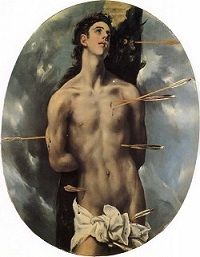 St. Sebastian was a captain of the guard in the Roman military. When the Emperor Diocletian turned on the Christians and began what would be called the “Great Persecution”, Sebastian refused to harm the followers of Christ.
St. Sebastian was a captain of the guard in the Roman military. When the Emperor Diocletian turned on the Christians and began what would be called the “Great Persecution”, Sebastian refused to harm the followers of Christ.
During Diocletian’s persecution of the Christians, Sebastian visited them in prison, bringing supplies and comfort. Reported to have healed the wife of a brother soldier by making the Sign of the Cross over her. He converted soldiers and a governor to Christianity. Diocletian reproached Sebastian for his supposed betrayal, and he commanded him to be led to the field and there to be bounden to a stake to be shot at. “And the archers shot at him till he was as full of arrows as an urchin,” leaving him there for dead. Miraculously, the arrows did not kill him. The widow of Castulus, Irene of Rome (later St. Irene), went to retrieve his body to bury it, and found he was still alive. She brought him back to her house and nursed him back to health. The other residents of the house doubted he was a Christian. One of those was a girl who was blind. Sebastian asked her “Do you wish to be with God?”, and made the sign of the Cross on her head. “Yes”, she replied, and immediately regained her sight. Sebastian then stood on a step and harangued Diocletian as he passed by; the emperor had him beaten to death and his body thrown in a privy. But in an apparition Sebastian told a Christian widow where they might find his body undefiled and bury it “at the catacombs by the apostles.”
Because Sebastian had been thought to have been killed by the arrows, and yet was not, and then later was killed by the same emperor who had ordered him shot, he is sometimes known as the saint who was martyred twice. – wiki
St. Joan of Arc “Bringing the Light of the Gospel Into History”
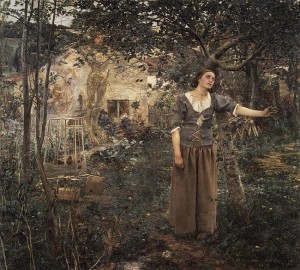 ommitment to sacramental life and to prayer: daily participation in Mass, frequent Confession and Communion and long periods of silent prayer before the Crucified One or the image of Our Lady. The young French peasant girl’s compassion and dedication in the face of her people’s suffering were intensified by her mystical relationship with God. One of the most original aspects of this young woman’s holiness was precisely this link between mystical experience and political mission. The years of her hidden life and her interior development were followed by the brief but intense two years of her public life: a year of action and a year of passion. At the beginning of 1429, Joan began her work of liberation. The many witnesses show us this young woman who was only 17 years old as a very strong and determined person, able to convince people who felt insecure and discouraged. Overcoming all obstacles, she met the Dauphin of France, the future King Charles VII, who subjected her to an examination in Poitiers by some theologians of the university. Their opinion was positive: they saw in her nothing evil, only a good Christian. On 22 March 1429 Joan dictated an important letter to the King of England and to his men at arms who were besieging the city of Orléans (ibid., pp. 221-222). Hers was a true proposal of peace in justice between the two Christian peoples in light of the Name of Jesus and Mary, but it was rejected and Joan had to gird herself to fight for the city’s liberation which took place on 8 May. The other culminating moment of her political action was the coronation of King Charles VII in Rheims on 17 July 1429. For a whole year, Joan lived with the soldiers, carrying out among them a true mission of evangelization. Many of them testified to her goodness, her courage and her extraordinary purity. She was called by all and by herself “La pucelle” (“the Maid”), that is, virgin. Joan’s passion began on 23 May 1430, when she fell into enemy hands and was taken prisoner. On 23 December she was led to the city of Rouen. There the long and dramatic Trial of Condemnation took place, that began in February 1431 and ended on 30 May with her being burned at the stake.
ommitment to sacramental life and to prayer: daily participation in Mass, frequent Confession and Communion and long periods of silent prayer before the Crucified One or the image of Our Lady. The young French peasant girl’s compassion and dedication in the face of her people’s suffering were intensified by her mystical relationship with God. One of the most original aspects of this young woman’s holiness was precisely this link between mystical experience and political mission. The years of her hidden life and her interior development were followed by the brief but intense two years of her public life: a year of action and a year of passion. At the beginning of 1429, Joan began her work of liberation. The many witnesses show us this young woman who was only 17 years old as a very strong and determined person, able to convince people who felt insecure and discouraged. Overcoming all obstacles, she met the Dauphin of France, the future King Charles VII, who subjected her to an examination in Poitiers by some theologians of the university. Their opinion was positive: they saw in her nothing evil, only a good Christian. On 22 March 1429 Joan dictated an important letter to the King of England and to his men at arms who were besieging the city of Orléans (ibid., pp. 221-222). Hers was a true proposal of peace in justice between the two Christian peoples in light of the Name of Jesus and Mary, but it was rejected and Joan had to gird herself to fight for the city’s liberation which took place on 8 May. The other culminating moment of her political action was the coronation of King Charles VII in Rheims on 17 July 1429. For a whole year, Joan lived with the soldiers, carrying out among them a true mission of evangelization. Many of them testified to her goodness, her courage and her extraordinary purity. She was called by all and by herself “La pucelle” (“the Maid”), that is, virgin. Joan’s passion began on 23 May 1430, when she fell into enemy hands and was taken prisoner. On 23 December she was led to the city of Rouen. There the long and dramatic Trial of Condemnation took place, that began in February 1431 and ended on 30 May with her being burned at the stake.
It was a great and solemn Trial, at which two ecclesiastical judges presided, Bishop Pierre Cauchon and the Inquisitor Jean le Maistre, but in fact it was conducted entirely by a large group of theologians from the renowned University of Paris, who took part in the Trial as assessors. They were French clerics, who, on the side politically opposed to Joan’s, had a priori a negative opinion of both her and her mission. This Trial is a distressing page in the history of holiness and also an illuminating page on the mystery of the Church which, according to the words of the Second Vatican Council, is “at once holy and always in need of purification” (Lumen Gentium, n. 8).
The Trial was the dramatic encounter between this Saint and her judges, who were clerics. Joan was accused and convicted by them, even condemned as a heretic and sent to the terrible death of being burned at the stake. Unlike the holy theologians who had illuminated the University of Paris, such as St Bonaventure, St Thomas Aquinas and Bl. Duns Scotus, of whom I have spoken in several Catecheses, these judges were theologians who lacked charity and the humility to see God’s action in this young woman. The words of Jesus, who said that God’s mysteries are revealed to those who have a child’s heart while they remain hidden to the learned and the wise who have no humility (cf. Lk 10:21), spring to mind. Thus, Joan’s judges were radically incapable of understanding her or of perceiving the beauty of her soul. They did not know that they were condemning a Saint. Joan’s appeal to the Pope, on 24 May, was rejected by the tribunal. On the morning of 30 May, in prison, she received Holy Communion for the last time and was immediately led to her torture in the Old Market Square. She asked one of the priests to hold up a processional Cross in front of the stake. Thus she died, her gaze fixed upon the Crucified Jesus and crying out several times the Name of Jesus (PNul, I, p. 457; cf. Catechism of the Catholic Church, n. 435). About 25 years later the Trial of Nullity, which opened under the authority of Pope Calixtus III, ended with a solemn sentence that declared the condemnation null and void (7 July 1456; PNul, II, pp. 604-610). This long trial, which collected the evidence of witnesses and the opinions of many theologians, all favourable to Joan, sheds light on her innocence and on her perfect fidelity to the Church. Joan of Arc was subsequently canonized by Benedict XV in 1920. Dear brothers and sisters, the Name of Jesus, invoked by our Saint until the very last moments of her earthly life was like the continuous breathing of her soul, like the beating of her heart, the centre of her whole life. The Mystery of the Charity of Joan of Arc which so fascinated the poet Charles Péguy was this total love for Jesus and for her neighbour in Jesus and for Jesus. This Saint had understood that Love embraces the whole of the reality of God and of the human being, of Heaven and of earth, of the Church and of the world. Jesus always had pride of place in her life, in accordance to her beautiful affirmation: “We must serve God first” (PCon, I, p. 288; cf. Catechismo della Chiesa Cattolica, n. 223). Loving him means always doing his will. She declared with total surrendur and trust: “I entrust myself to God my Creator, I love him with my whole my heart” (PCon, I, p. 337). With the vow of virginity, Joan consecrated her whole being exclusively to the one Love of Jesus: “it was the promise that she made to Our Lord to preserve the virginity of her body and her mind well” (PCon, I, pp. 149-150). Virginity of soul is the state of grace, a supreme value, for her more precious than life. It is a gift of God which is to be received and preserved with humility and trust. One of the best known texts of the first Trial concerns precisely this: “Asked if she knew that she was in God’s grace, she replied: ‘If I am not, may it please God to put me in it; if I am, may it please God to keep me there’” (ibid., p. 62; cf. Catechism of the Catholic Church, n. 2005).
prison, she received Holy Communion for the last time and was immediately led to her torture in the Old Market Square. She asked one of the priests to hold up a processional Cross in front of the stake. Thus she died, her gaze fixed upon the Crucified Jesus and crying out several times the Name of Jesus (PNul, I, p. 457; cf. Catechism of the Catholic Church, n. 435). About 25 years later the Trial of Nullity, which opened under the authority of Pope Calixtus III, ended with a solemn sentence that declared the condemnation null and void (7 July 1456; PNul, II, pp. 604-610). This long trial, which collected the evidence of witnesses and the opinions of many theologians, all favourable to Joan, sheds light on her innocence and on her perfect fidelity to the Church. Joan of Arc was subsequently canonized by Benedict XV in 1920. Dear brothers and sisters, the Name of Jesus, invoked by our Saint until the very last moments of her earthly life was like the continuous breathing of her soul, like the beating of her heart, the centre of her whole life. The Mystery of the Charity of Joan of Arc which so fascinated the poet Charles Péguy was this total love for Jesus and for her neighbour in Jesus and for Jesus. This Saint had understood that Love embraces the whole of the reality of God and of the human being, of Heaven and of earth, of the Church and of the world. Jesus always had pride of place in her life, in accordance to her beautiful affirmation: “We must serve God first” (PCon, I, p. 288; cf. Catechismo della Chiesa Cattolica, n. 223). Loving him means always doing his will. She declared with total surrendur and trust: “I entrust myself to God my Creator, I love him with my whole my heart” (PCon, I, p. 337). With the vow of virginity, Joan consecrated her whole being exclusively to the one Love of Jesus: “it was the promise that she made to Our Lord to preserve the virginity of her body and her mind well” (PCon, I, pp. 149-150). Virginity of soul is the state of grace, a supreme value, for her more precious than life. It is a gift of God which is to be received and preserved with humility and trust. One of the best known texts of the first Trial concerns precisely this: “Asked if she knew that she was in God’s grace, she replied: ‘If I am not, may it please God to put me in it; if I am, may it please God to keep me there’” (ibid., p. 62; cf. Catechism of the Catholic Church, n. 2005).
Our Saint lived prayer in the form of a continuous dialogue with the Lord who also illuminated her dialogue with the judges and gave her peace and security. She asked him with trust: Sweetest God, in honour of your holy Passion, I ask you, if you love me, to show me how I must answer these men of the Church” (PCon, I, p. 252). Joan saw Jesus as the “King of Heaven and of the earth”. She therefore had painted on her standard the image of “Our Lord holding the world” (ibid., p. 172): the emblem of her political mission. The liberation of her people was a work of human justice which Joan carried out in charity, for love of Jesus. Her holiness is a beautiful example for lay people engaged in politics, especially in the most difficult situations. Faith is the light that guides every decision, as a century later another great Saint, the Englishman Thomas More, was to testify.
In Jesus Joan contemplated the whole reality of the Church, the “Church triumphant” of Heaven, as well as the “Church militant” on earth. According to her words, “About Jesus Christ and the Church, I simply know they’re just one thing” (ibid., p. 166). This affirmation, cited in theCatechism of the Catholic Church (n. 795), has a truly heroic character in the context of theTrial of Condemnation, before her judges, men of the Church who were persecuting and condemning her. In the Love of Jesus Joan found the strength to love the Church to the very end, even at the moment she was sentenced. I like to recall that St Joan of Arc had a profound influence on a young Saint of the modern age: Thérèse of the Child Jesus. In the context of a completely different life, spent in the cloister, the Carmelite of Lisieux felt very close to Joan, living in the heart of the Church and participating in Christ’s suffering for the world’s salvation. The Church has brought them together as Patronesses of France, after the Virgin Mary. St Thérèse expressed her desire to die, like Joan, with the Name of Jesus on her lips (Manoscritto B, 3r), and she was motivated by the same great love for Jesus and her neighbour, lived in consecrated virginity. Dear brothers and sisters, with her luminous witness St Joan of Arc invites us to a high standard of Christian living: to make prayer the guiding motive of our days; to have full trust in doing God’s will, whatever it may be; to live charity without favouritism, without limits and drawing, like her, from the Love of Jesus a profound love for the Church. Thank you.
St. Hilary of Poitiers, Father and Doctor of the Church…defender of the Blessed Trinity
Born of wealthy polytheistic, pagan nobility, Hilary’s early life was uneventful as he married, had children (including Saint Abra), and studied on his own. Through his studies he came to believe in salvation through good works, then monotheism. As he studied the Bible for the first time, he literally read himself into the faith, and was converted by the end of the New Testament.
Hilary lived the faith so well he was made bishop of Poitiers from 353 to 368. Hilary opposed the emperor’s attempt to run Church matters, and was exiled; he used the time to write works explaining the faith. His teaching and writings converted many, and in an attempt to reduce his notoriety he was returned to the small town of Poitiers where his enemies hoped he would fade into obscurity. His writings continued to convert pagans.
“Obtain, O Lord, that I may keep ever faithful to what I have professed in the symbol of my regeneration, when I was baptized in the Father, in the Son and in the Holy Spirit. That I may worship you, our Father, and with you, your Son; that I may deserve your Holy Spirit, who proceeds from you through your Only Begotten Son… Amen”
St. Catherine of Genoa and the Experience of Purgatory
VATICAN CITY, 12 JAN 2011 (vatican.va) –
Dear Brothers and Sisters,
After Catherine of Siena and Catherine of Bologna, today I would like to speak to you about another Saint: Catherine of Genoa, known above all for her vision of purgatory. The text that describes her life and thought was published in this Ligurian city in 1551. It is in three sections: her Vita [Life], properly speaking, the Dimostratione et dechiaratione del purgatorio — better known as Treatise on purgatory — and her Dialogo tra l’anima e il corpo (cf. Libro de la Vita mirabile et dottrina santa, de la beata Caterinetta da Genoa. Nel quale si contiene una utile et catholica dimostratione et dechiaratione del purgatorio, Genoa 1551). The final version was written by Catherine’s confessor, Fr Cattaneo Marabotto.
Catherine was born in Genoa in 1447. She was the youngest of five. Her father, Giacomo Fieschi, died when she was very young. Her mother, Francesca di Negro provided such an effective Christian education that the elder of her two daughters became a religious.
When Catherine was 16, she was given in marriage to Giuliano Adorno, a man who after various trading and military experiences in the Middle East had returned to Genoa in order to marry.
Married life was far from easy for Catherine, partly because of the character of her husband who was given to gambling. Catherine herself was at first induced to lead a worldly sort of life in which, however, she failed to find serenity. After 10 years, her heart was heavy with a deep sense of emptiness and bitterness.
A unique experience on 20 March 1473 sparked her conversion. She had gone to the Church of San Benedetto in the monastery of Nostra Signora delle Grazie [Our Lady of Grace], to make her confession and, kneeling before the priest, “received”, as she herself wrote, “a wound in my heart from God’s immense love”. It came with such a clear vision of her own wretchedness and shortcomings and at the same time of God’s goodness, that she almost fainted.
Her heart was moved by this knowledge of herself — knowledge of the empty life she was leading and of the goodness of God. This experience prompted the decision that gave direction to her whole life. She expressed it in the words: “no longer the world, no longer sin” (cf. Vita Mirabile, 3rv). Catherine did not stay to make her Confession.
On arriving home she entered the remotest room and spent a long time weeping. At that moment she received an inner instruction on prayer and became aware of God’s immense love for her, a sinner. It was a spiritual experience she had no words to describe ( cf. Vita Mirabile, 4r).
It was on this occasion that the suffering Jesus appeared to her, bent beneath the Cross, as he is often portrayed in the Saint’s iconography. A few days later she returned to the priest to make a good confession at last. It was here that began the “life of purification” which for many years caused her to feel constant sorrow for the sins she had committed and which spurred her to impose forms of penance and sacrifice upon herself, in order to show her love to God.
On this journey Catherine became ever closer to the Lord until she attained what is called “unitive life”, namely, a relationship of profound union with God.
In her Vita it is written that her soul was guided and instructed from within solely by the sweet love of God which gave her all she needed. Catherine surrendered herself so totally into the hands of the Lord that she lived, for about 25 years, as she wrote, “without the assistance of any creature, taught and governed by God alone” (Vita, 117r-118r), nourished above all by constant prayer and by Holy Communion which she received every day, an unusual practice in her time. Only many years later did the Lord give her a priest who cared for her soul.
Catherine was always reluctant to confide and reveal her experience of mystical communion with God, especially because of the deep humility she felt before the Lord’s graces. The prospect of glorifying him and of being able to contribute to the spiritual journey of others alone spurred her to recount what had taken place within her, from the moment of her conversion, which is her original and fundamental experience.
The place of her ascent to mystical peaks was Pammatone Hospital, the largest hospital complex in Genoa, of which she was director and animator. Hence Catherine lived a totally active existence despite the depth of her inner life. In Pammatone a group of followers, disciples and collaborators formed around her, fascinated by her life of faith and her charity.
Indeed her husband, Giuliano Adorno, was so so won over that he gave up his dissipated life, became a Third Order Franciscan and moved into the hospital to help his wife.
Catherine’s dedication to caring for the sick continued until the end of her earthly life on 15 September 1510. From her conversion until her death there were no extraordinary events but two elements characterize her entire life: on the one hand her mystical experience, that is, the profound union with God, which she felt as spousal union, and on the other, assistance to the sick, the organization of the hospital and service to her neighbour, especially the neediest and the most forsaken. These two poles, God and neighbour, totally filled her life, virtually all of which she spent within the hospital walls.
Dear friends, we must never forget that the more we love God and the more constantly we pray, the better we will succeed in truly loving those who surround us, who are close to us, so that we can see in every person the Face of the Lord whose love knows no bounds and makes no distinctions. The mystic does not create distance from others or an abstract life, but rather approaches other people so that they may begin to see and act with God’s eyes and heart.
Catherine’s thought on purgatory, for which she is particularly well known, is summed up in the last two parts of the book mentioned above: The Treatise on purgatory and the Dialogues between the body and the soul. It is important to note that Catherine, in her mystical experience, never received specific revelations on purgatory or on the souls being purified there. Yet, in the writings inspired by our Saint, purgatory is a central element and the description of it has characteristics that were original in her time.
The first original passage concerns the “place” of the purification of souls. In her day it was depicted mainly using images linked to space: a certain space was conceived of in which purgatory was supposed to be located.
Catherine, however, did not see purgatory as a scene in the bowels of the earth: for her it is not an exterior but rather an interior fire. This is purgatory: an inner fire.
The Saint speaks of the Soul’s journey of purification on the way to full communion with God, starting from her own experience of profound sorrow for the sins committed, in comparison with God’s infinite love (cf. Vita Mirabile, 171v).
We heard of the moment of conversion when Catherine suddenly became aware of God’s goodness, of the infinite distance of her own life from this goodness and of a burning fire within her. And this is the fire that purifies, the interior fire of purgatory. Here too is an original feature in comparison with the thought of her time.
In fact, she does not start with the afterlife in order to recount the torments of purgatory — as was the custom in her time and perhaps still is today — and then to point out the way to purification or conversion. Rather our Saint begins with the inner experience of her own life on the way to Eternity.
“The soul”, Catherine says, “presents itself to God still bound to the desires and suffering that derive from sin and this makes it impossible for it to enjoy the beatific vision of God”. Catherine asserts that God is so pure and holy that a soul stained by sin cannot be in the presence of the divine majesty (cf. Vita Mirabile, 177r).
We too feel how distant we are, how full we are of so many things that we cannot see God. The soul is aware of the immense love and perfect justice of God and consequently suffers for having failed to respond in a correct and perfect way to this love; and love for God itself becomes a flame, love itself cleanses it from the residue of sin.
In Catherine we can make out the presence of theological and mystical sources on which it was normal to draw in her time. In particular, we find an image typical of Dionysius the Areopagite: the thread of gold that links the human heart to God himself. When God purified man, he bound him with the finest golden thread, that is, his love, and draws him toward himself with such strong affection that man is as it were “overcome and won over and completely beside himself”.
Thus man’s heart is pervaded by God’s love that becomes the one guide, the one driving force of his life (cf. Vita Mirabile, 246rv). This situation of being uplifted towards God and of surrender to his will, expressed in the image of the thread, is used by Catherine to express the action of divine light on the souls in purgatory, a light that purifies and raises them to the splendour of the shining radiance of God (cf. Vita Mirabile, 179r).
Dear friends, in their experience of union with God, Saints attain such a profound knowledge of the divine mysteries in which love and knowledge interpenetrate, that they are of help to theologians themselves in their commitment to study, to intelligentia fidei, to an intelligentia of the mysteries of faith, to attain a really deeper knowledge of the mysteries of faith, for example, of what purgatory is.
With her life St Catherine teaches us that the more we love God and enter into intimacy with him in prayer the more he makes himself known to us, setting our hearts on fire with his love.
In writing about purgatory, the Saint reminds us of a fundamental truth of faith that becomes for us an invitation to pray for the deceased so that they may attain the beatific vision of God in the Communion of Saints (cf. Catechism of the Catholic Church, n. 1032).
Moreover the humble, faithful and generous service in Pammatone Hospital that the Saint rendered throughout her life is a shining example of charity for all and an encouragement, especially for women who, with their precious work enriched by their sensitivity and attention to the poorest and neediest, make a fundamental contribution to society and to the Church. Many thanks.
For more on St. Catherine of Genoa visit Discerning Hearts post St. Catherine of Genoa…it’s all about Divine Love

